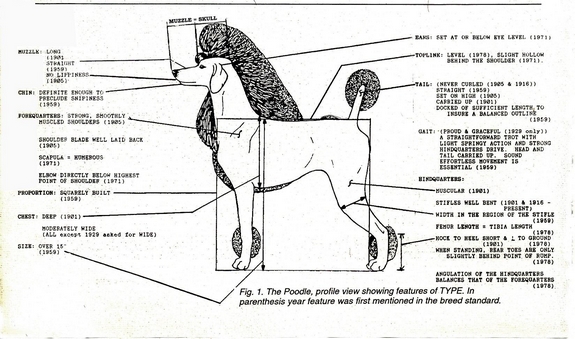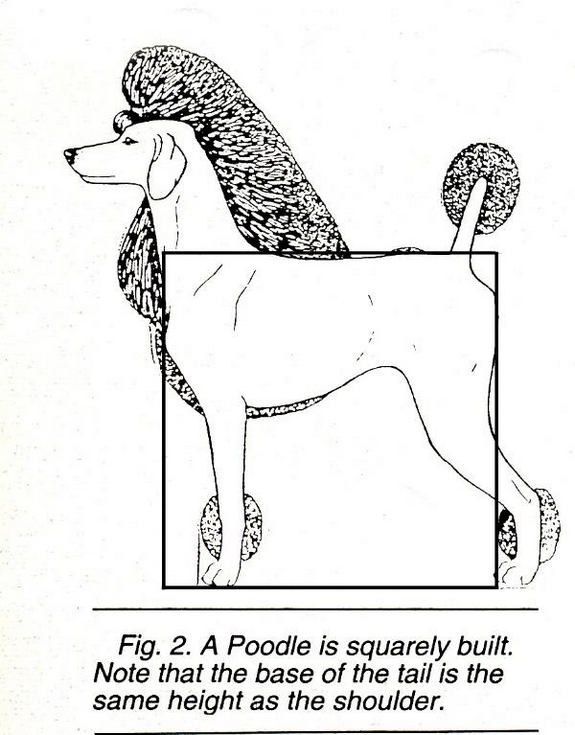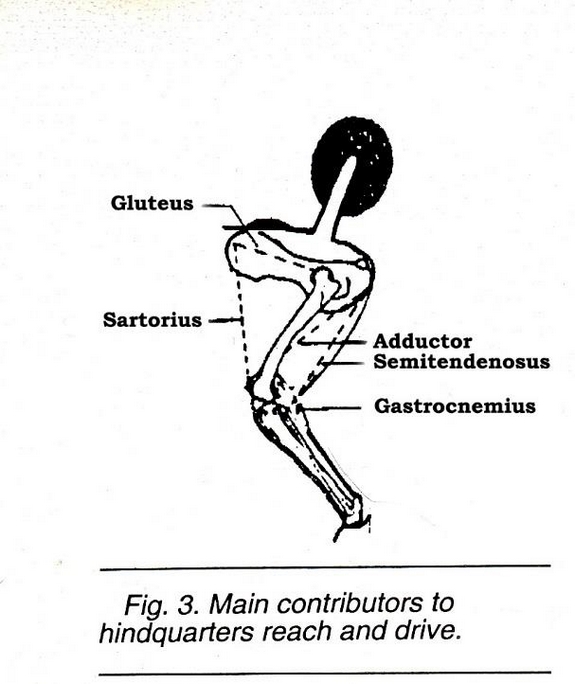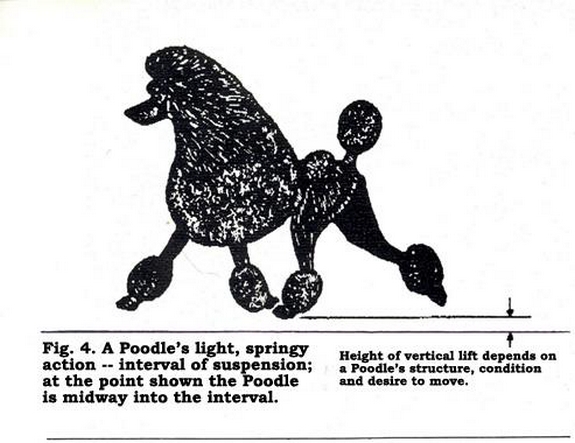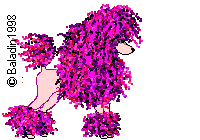Author's note: This article appeared in the Poodle Variety Magazine 1993 Stud Issue.
Poodle Breed Type
- One Interpretation
by John A. Fowler and Sheila Fowler
![]()
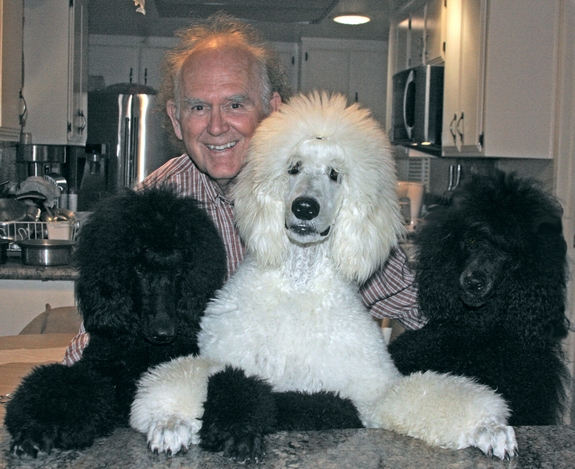
![]()
John Fowler of Summermist Standard Poodles
Figures in brackets refer to references at end of the article.
OUR PURSUIT of Poodles was spontaneous. Like many people who started in purebred dogs, we chose a breed because something caught our eye that we did not stop to analyze. We liked what we saw, no, we loved what we saw. Poodles! They are unique. But what does that mean: they are unique? The dictionary defines unique as the one and only, having no like or equal. So, of all the breeds of dogs, Poodles are the one and only.
Fanciers of other breeds may take issue with this accent on uniqueness; actually, each breed is unique. The uniqueness can be identified by various features, and these features are described in the breed standard. Every breed of dog recognized by the American Kennel Club (AKC) has a breed standard. This is a relatively short document that defines a breed's type. A breed's type is the characteristic qualities distinguishing a breed; the embodiment of a standard's essentials [1, pg. 714]. While the AKC and breed authorities subscribe to this definition of breed type, the word type is utilized in such a manner by many canine fanciers, that confusion is created as to whether one should breed for a particular kennel "type", a country's "type" or breed type [2,3,5,7, et. al.]
Biologists have classified the domestic dog as the species canis familiaris. And within this species, the AKC currently recognizes 136 breeds of dogs [1, pg. Xl](Author notes 192 by 2019). A breed is a domestic race of dogs (selected and maintained by man) with a common gene pool and a characterized appearance (phenotype) and function [1, pg. 692].
The various breeds of dogs have been created from the wolf by selective breeding and crossbreeding to attain various functions [4, pg. 20]. To maintain these functions in the face of genetic variation and environmental influences, breed standards attempt to perform the following functions:
1. Stabilization of breeds created by recent crossbreeding:
2. Communication and Preservation of a breed's type:
3. Source of authority for a breed's type.
![]()
"Without the breed standard, breed type would become anyone's opinion."
![]()
THE BREED STANDARD
COMPARED to the origins of most domesticated dogs of today, breed standards have not existed very long. The first Poodle breed standard published in the United States was in 1901 [6, pg. 16].
The breed standard seeks to assure preservation of the breed's characteristics. It identifies the features that make the breed unique — breed type.
Many believe the breed standard describes the perfect specimen of their breed. This allows a subtle misunderstanding of the breed standard and a lack of appreciation for what it is really doing for a breed. Perfection is a very difficult model to achieve. A perfect model cannot be described by indefinite adverbs and adjectives like slightly, sloping, gradually or deep [3, pg. 91]. However, perfection in the sense that all of the features described in the breed standard can be found in the "ideal" specimen is a more practical expectation.
One function of a breed standard is to stabilize breed type for breeds created by recent crossbreeding. Recent is a relative term. Compared to the origin of breeds like the Pharaoh Hound, breeds like the Boxer or Weimaraner must assure that the most recent breed type does not "drift" to one of the foundation breed types. The standard, then, controls the phenotype, hence the genotype of breed type.
Do not become confused. A breed standard is not equivalent to breed type. A breed standard is a description document. It describes the essentials of a breed's type: it is a collection of words — not breed type. The proper understanding of a breed standard requires comparison of the written description to various specimens of the breed. It is important to understand how a feature can vary within a breed and how such features contribute to the breed's uniqueness.
It is after much education and experience that one can begin to have a personal opinion of breed type [12, pg. 104]. People are known to have opinions regarding breed type, e.g. that the head determines type. In general, a breed's type consists of certain physical and behavioral attributes which include features like the ears, eyes, muzzle, size, proportion, coat, color and temperament to name a few [3, pg. 88]. But of greater importance is the way in which such features are taken collectively with other features to achieve a distinguishing description. In this way, one and only one breed type is communicated to everyone. The understanding of the standard is enhanced by the parent breed club with illustrated breed standards, educational seminars and conformation shows. These serve to initiate discussions and interactions among breeders, fanciers and judges that ordinarily would not occur.
To gain a better understanding of the qualities of one's breed, the careful study of another breed creates better perspective for the descriptions of one's first breed [1 1, pg. 128]. To take a step further, the study of other animals that do the sorts of things dogs do can give better insight into form and function [4, pg. 24]; for example, wolves, Cape Hunting Dogs and Dingos to name a few. Horses can be useful from the perspective of understanding how function relates to form, but in general the bones of horses are somewhat different from those found in dogs. Such different anatomy supports different functions that must be considered [4, pg. 35].
One final point on the breed standard will close this section. Judges make their decisions in a brief time span at a show, using the breed standard as their selection guide. They also bring, in many cases, years of experience on which to base their choices. The show environment creates competition and a forum to display and discuss the world of breeding dogs. The shows may be the reason many people participate in breeding dogs and, while they are a necessary part of our canine activities, only the surface is seen. To consistently bring good specimens to the show ring requires knowledge of the breed, knowledge of attributes and deficiencies within pedigrees, verification of form and function, proper canine socialization, nutritious feeding programs, attendance at seminars and many other factors too numerous to mention. These efforts take years of preparation with uncompromising dedication. At a judging seminar we attended some years ago, a great deal of discussion was being held on the detail contained in a particular breed standard. Judges were complaining about details like angles of bones and head planes. The desire was to remove all of these things because these judges could not verify them in the show ring.
If such details are removed, so too is important information the breeder needs to verify that a particular feature is improving. It is the breed standard that provides the authority to attain particular features. These features constitute breed type and must be verified in some detail by the breeder. The verification by the judge is more of an appreciation of the breeder's effort. A breed standard is a breeding document first and a judging document second.
![]()
"The study of other animals that do the sorts of things dogs do can give better insight into form and function."
![]()
The breed standard is the one thing breeders and judges must have in common. Judges study the breed standards and are tested by AKC. If breeders use the breed standard in their breeding programs, they have a better chance of presenting specimens that meet the judging criteria. Without the breed standard, breed type would become anyone's opinion.
The breed standard is the source of authority for breed type. Understanding the importance of the breed standard is essential to understanding breed type.
BREED TYPE
THE MEANING of the word type should never be misinterpreted. It is essential for a breed. There can be only one type of Poodle. Some tend to be lenient and use the word type to refer to dogs of one kennel compared to the dogs of another kennel. Breed type is a collection of features that combine in a unique way to create a breed. No one is free to alter those features. What we are free to alter are features not essential for breed type. It is these latter features that create variations within the breed along with deviations from breed type that result in different kinds of Poodles. Breed type consists of many elements, all of which are included in the breed standard. In general, the following compose categories important to define breed type:
1. Unique features. Those features that uniquely distinguish one breed from another. May be referred to as primary features of type [3, pg. 86].
2. Secondary features. Singular or multiple features that another breed (or breeds) may have, but are necessary in a breed for type [3, pg. 86].
3. Genetics. By definition, a breed depends on a "common gene pool" and, hence, the various features depend on genetic expression through inheritance.
4. Soundness. Defined by the AKC as the state of mental and physical health when all organs and faculties are complete and functioning normally, each in its rightful relation to the other. [1, pg. 712 & 13, pg. 1 1 1].
Examples of primary features include the butterfly like ears of the Papillon, the special face markings of the Alaskan Malamute and the Poodle's coat of hair [5, pg. 335].
One example of a secondary feature for the Poodle is that the length of the muzzle is equal to the length of the skull. Several breeds have the same requirement, e.g. the Wirehaired Pointing Griffon, the Ibizan Hound and the Giant Schnauzer. While all of these heads have the same secondary feature in common, they are distinctly different from one another due to a combination of other characteristics.
Another example of a secondary feature is "hock to heel short". While this is stated differently than any other breed, the intent is a short or well let down hock. The attempt at a different wording is not unique when one realizes that 71 breed standards call for short hocks in 23 different ways [3, pg. 91].
Genetics is a branch of biology. Classically, dog breeders use Mendelian principles to achieve certain features in a breeding program. Most breeders are familiar with Gregor Mendel's laws of inheritance derived from his experiments with garden peas in the 1860s [14, pg. 5]. The laws he developed have benefited man's understanding of many modes of inheritance and helped identify the gene as the fundamental unit of inheritance. Today, these laws are consistent with recent discoveries, but the new understandings being gained from molecular cell biology are allowing even greater insight to the genetic process.
Developmental genes are responsible for the growth and development of our dogs. Bones, muscle, organs, etc. all must change in size and complexity from conception to adulthood. It is the expression of these genes into particular genotype that attracts many fanciers to a breed. And it is the understanding of this process that delivers repeated success. There are systems whose development can be very subtle and become more troublesome than a short neck or a low tail set. These systems include the nervous system, the circulatory system, the endocrine system and the immune system. Although beyond the intent of this discussion, these systems and others are crucial to the health and longevity of any breed. Soundness is a universal term used among dog fanciers everywhere. The definition provided by AKC
![]()
"The show ring is where most people develop their opinion of type."
![]()
(see above), correctly combines the physical and mental health of the dog. Vicki Jones in her Alaskan Malamutebreed column says that "a correct specimen of any breed must possess both type and soundness" [10, pg. 109]. So,too, must a Poodle possess type and soundness. To evaluate soundness is a task breeders, fanciers and judgesmust perform. For most evaluations, only relatively minor defects are usually encountered, but severe conditions dooccur and can require the assistance of one's veterinarian.
The mental attributes of the dog are of utmost importance, for without adequate intelligence and proper temperament, the specimen with the best conformation is worthless. The brain is the central processor of all of the dog's senses. The quality of this one entity provides clues to the mental soundness of the dog. When health problems do occur, it is a change in behavior that usually indicates a problem.
If a dog is sound, it is not necessarily faultless, but it is healthy and free of gaiting faults. It is important to gain a working knowledge of canine anatomy to provide a good foundation to correctly evaluate gaiting or conformation faults. Faults are anomalies that impede function and a flaw is a cosmetic defect [15, pg. 1 12]. The novice should begin by reading McDowell Lyon's The Dog In Action, Rachel Page Elliot's The New Dog Steps and Curtis Brown's Dog Locomotion and Gait Analysis. These reference books will provide anyone with a firm foundation of canine anatomy and canine gait evaluation no matter what breed of dog one desires to own.
POODLE BREED TYPE - ONE INTERPRETATION
"WHAT MAKES a Poodle a Poodle? What are the unique distinguishing features of the Poodle?" These are questions that Poodle fanciers have trouble articulating. Through discussions and seminars we find two areas that seem to prevent people from becoming more knowledgeable. First, the Poodle has a coat of hair that makes it hard to ascertain certain features which can only be evaluated by touch. Second, breeders and fanciers do not discuss their Poodles in terms of the breed standard. There may be other reasons, such as lack of experience, but these two reasons stand out.
The ability to faithfully reproduce a lineage of Poodles that are highly recognizable and desired is the sign of breeding success. The word interpretation as it applies to breeding Poodles conveys the option to have many variations within the breed and this allows a sense of individual contribution to the breed. Such interpretations should be made with a complete understanding of the breed standard and how it relates to the benefit of the breed. The prudent approach is for such interpretations to be performed by persons with significant breed knowledge and experience.
Rather than list every detail that we believe makes a Poodle we will discuss two aspects: General overview and selected details.
GENERAL OVERVIEW
THERE ARE TRADEOFFS in everything we do. Good coat/bad tailset; good head/straight shoulder; long ear leather/light eyes, etc. As breeders, we have the difficult duty of raising, and loving, a great show potential Poodle, only to watch in dismay a fault (or faults) creep in that limits or prevents the show career.
The show ring is where most people develop their opinion of type. Most people want to win. To do that they want head and tail up, reach and drive, tons of coat and showmanship! A good starting point for a general overview is showmanship: they either have it or they don't. One cannot easily make any dog "show". This is the result of breeding — strongly genetic. Showmanship includes many styles, and our style is the one that includes head and tail up, elegant, moving soundly and carrying himself proudly. Naturally this all centers around temperament. The Poodle's natural disposition must be happy and self-confident to be a show dog. Shyness and aggression must never be accepted for the Poodle. We must be able to depend on a Poodle's behavior.
Referring to the Poodle breed standard, the first paragraph, taken in total, gives the basis for the general overview. No details, more like an outline. Outlines are important to give an overall impression during judging. But judging
![]()
"The mental attributes of the dog are of utmost important, for without adequate intelligence and proper temperaments, the specimen with the best conformation is worthless."
![]()
occurs in a brief span of time on six months and older Poodles. As breeders, we select our show and breeding stock based upon certain qualities. These qualities are the features for breed type and some are easier to acquire than others. Many of these qualities are well described for the adult (the experienced breeder learns how these qualities appear in very young puppies).
For reference, Figure 1 shows the Poodle with some of the various features of type labeled. A single year listed indicates the breed standard version the feature was first described and has subsequently been described in all versions up to and including the current version.
Click to view larger image
Two features are added for interest only: the 1905 and 1916 description of tail and the 1929 description of gait. While the 1905 and 1916 versions give fifteen points for General Appearance and Movement, only the 1929 version describes movement. There have been nine versions of the Poodle breed standard published in the U.S. and the years of publication are: 1901 , 1905, 1916, 1929, 1959, 1971, 1978, 1984 and 1990.
At first, the square build of the Poodle may seem like a secondary feature, but closer examination reveals how features can combine to become unique. The square proportion is for the highest point of the shoulder to be equal to the body length from the breast bone to the point of the rump.
A second feature adds uniqueness: the topline is level from the highest point of the shoulder to the base of the tail. The topline, then, forms the top edge of the square (see Figure 2). This is surely not well understood, because so many exhibitors stack their dogs in the show ring with the rear legs overly outstretched. Naturally, as the rear legs are drawn backwards, as well as outwards the height of the tail is lowered and the topline becomes sloping and not level. In many cases a perfectly good topline is ruined by such ignorance.
Note too, that the proportion of height at the shoulder to body length from breast bone to point of rump is an approximate measurement, not an exact measurement.
Click to view larger image
Here is where there is room for interpretation. To what degree should a Poodle be square? As with each part of the breed standard, there is not a simple answer. However, there are guidelines: The early breed standards allowed for a bitch to be longer than a male [6, pg. 20]; the closer coupled a dog is made, the more likely the front and rear legs will interfere causing a variety of gait faults such as pacing or sidewinding [4, pg. 66]; too long a Poodle will result in a deviation from type. Breeds of similar type to the Poodle, like the Portuguese Water Dog and the Irish Water Spaniel, although having a level topline, have a rectangular body proportion [1]. And while the Poodle topline is to be level, there is another piece of information that is rarely discussed: . with the exception of a slight hollow just behind the shoulder. " Many other breeds call for a topline that is sloping, i.e. higher at the shoulders than at the tail. The word hollow means depressed below the surrounding surface; concave [9, pg. 669]. This provides for a different shape to the back for the Poodle as shown in Figure 1. This is a feature not always seen in Poodle puppies, as they usually have a sloping topline that should become level with maturity.
SELECTED DETAILS
BREED TYPE consists of many attributes, many of which can be found in many Poodles, and all of the essential attributes of type are described in the breed standard. Those specimens that exhibit most of these attributes are the most typey. It is the recognition of these elements of type that allows one to fully appreciate the Poodle. This is especially important to the breeder, but is also invaluable to the discerning judge. If such features are not known, how can one evaluate if they are right or wrong or that one specimen has an improvement over another?
We have selected a few of the details of Poodle breed type that we believe would help most people achieve a better understanding.
1. MUZZLE. The muzzle should appear long. Here some interpretation is necessary — not so Long as to appear excessive, but long enough to pick up a duck in the mouth and to house the organs for scent. What about the Miniature or the Toy?
![]()
"The ability to faithfully reproduce a lineage of Poodles that are highly recognizable and desired is the sign of breeding success."
![]()
Not a problem; remember they are scaled down versions of the Standard, not equivalent in function.
While the muzzle is to have a long appearance, its length is governed by the skull: they are to be equal in length. So, longer is not necessarily better, as the muzzle longer than the skull is as faulty as a muzzle shorter than the skull. The next adjective for the muzzle is "straight". Not ram-nosed, not a roman nose, but straight. This is more of a flaw than a fault, however, because the function can still be performed. A muzzle that is not straight is a deviation from type. While a muzzle is to be fine, the chin is to be definite enough to preclude snipiness. Here, the Illustrated Poodle Breed Standard is very helpful, since the drawings show that the muzzle is to have fullness at the end and not be pointed or snippy [8, pg. 1 1].
Our final muzzle feature is chiseling under the eyes. The expression is degraded without chiseling. If this is a foreign term to you, this term comes from woodworking. If a wood chisel is used to cut a groove in a piece of wood, there is a characteristic pattern left. This pattern is similar to what is desired beneath the eyes.
2. SKULL. We continue to hear some people thinking that a Poodle's head must be narrow. The 1901 breed standard asked for the "skull to be large with plenty of room for brain power." And while the 1905, 1916 and 1929 breed standards stated "skull not broad," since 1959 the only explicit requirement on the skull is that it be moderately rounded. The words "not broad" are not intended to mean narrow.
For the past 34 years, the only explicit requirement regarding width of the head is for the cheekbones and muscles to be flat. Cheekbones are the curved bones just under the eyes identified as the zygomatic arch in canine anatomy books. What is desired is for this arch to be minimized or nearly flat. This bone is an attachment point for the jaw muscles and provides protection for the eyes, so it performs an important function. While bulginess is to be avoided, some outward curvature is practical to protect the eyes from branches, etc.
Obviously for the muzzle to be described as fine, there needs to be some accompanying fineness of the skull, but the skull houses the brain. The brain is the central processor for the Poodle's senses, nerve endings and many regulatory functions — just to name a few important reasons for not making it too small. When flat cheekbones and muscles are present, usually the head is acceptable; if not, the guideline is still flat cheekbones and muscles and not a narrow skull.
3. HINDQUARTERS. Do you know what width in the region of the stifles means? We have been told it means separation between the right and left stifle. And that is why some people stack their Poodles wide in the rear. This is incorrect. A Poodle's stifle joint is wide, as viewed from the side. A strongly muscled joint is being described.
These muscles provide the rear legs with their range of motion and the strong hindquarters drive. To do this the muscles must attach at two points (this is for explanation purposes, since some muscles have multiple attachment points). When muscles contract, they shorten. This causes the leg to move. One of the two attachment points is on the leg bones, the other is on the hip. The angle of the hip is an important consideration, since too steep a hip angle reduces the ability to have good rear extension, and too flat a hip (pelvis) reduces the ability of the rear leg to reach forward.
Click to view larger image
For strong hindquarters drive, it is advantageous to have the muscles responsible to be long. To do this the pelvis should not be at too steep an angle. We prefer the slope of the pelvis to be approximately fifteen degrees sloping from the ilium to the ischium. The pelvic angle shown in the Illustrated Poodle Breed Standard on the top of page 4 is drawn at an angle of approximately 25 degrees. (The angle of the pelvis is not controlled by the breed standard).
The adductor magnus et brevis (or adductor) is the muscle most responsible for the strong hindquarters drive and attaches to the ischium as shown in Figure 3. As the pelvis becomes steeper this muscle becomes shorter because the distance between the ischium and the adductor muscle attachment point on the leg bone (the femur) is shortened. Shorter muscles can reduce the length of stride and are less enduring. Another advantage of a fifteen-degree pelvis is that the tailset is naturally higher set.
4. FEET. These can be very misleading. We usually feel and see the feet when our Poodles are at rest or standing. But it is the dynamic quality of the feet that we need to understand. One can get a good idea of what we mean if a running Standard Poodle steps on your toe. The strength and agility of the Poodle depend on well arched toes, as this indicates good tendon quality. Heavier Poodles will have feet in proportion to their weight. The feet are supporting the body weight and the surface area of the pad is rated at pounds per square inch. So, some enlargement must be made for larger Poodles.
The pads should be thickly padded (to allow travel over rough terrain in any weather) and the webbing should be well developed. Because the Poodle's function was a water retriever, his swimming function needs attention, even though most are not used for this function today.
5. GAIT. Today, more than any other feature, we see a lack of understanding of what constitutes Poodle gait on the part of the handler, breeder and judge. A Poodle's square proportions with good front and rear angulation provide a collected straight forward trot with light, springy action with sound, effortless movement and strong hindquarters drive.
![]()
"The strength and agility of the Poodle depend on well arched toes, as this indicates good tendon quality."
![]()
The trot is a two-beat gait where the diagonal legs (right front with left rear or left front with right rear) move together [4, pg. 58]. A diagonal pair touch the ground together, propel and leave the ground together. The light springy action called for in the Poodle breed standard is the result of soundness, strength, balance and good angulations. In the trot, these factors contribute to the Poodle moving in a manner that results in a slight lift, vertically, as well as the necessary forward motion, until the two driving (diagonal) legs have completed their cycle of moving the body forward. This interval is also referred to as the period of suspension [16, pg. 25].
During the interval when one pair of driving legs leaves the ground and the other pair of legs is extending forward to meet the ground, the Poodle is in the air. How long this interval is, as well as how much ground is traveled per stride, is a function involving the physical length of bones and muscles as well as the Poodle's condition and desire to perform the trotting function. This is not unlike a runner who at the beginning of the run is fresh, his muscular reserve allows him to take longer steps by "springing" into the air. Without this spring, neither the athlete nor the Poodle could achieve the desired longer length of stride.
Overall, the most functional conformation combined with the best mental functions will provide the best moving Poodles. Poodles moving without this action are not expressing breed type. Because the Poodle's gait is explicitly described in the breed standard, it becomes a part of breed type. The correct Poodle gait combined with a developed handler/Poodle rapport is a most beautiful sight. Such virtues must be shown with a controlled collected gait. Everyone enjoys seeing a "mover" put on a show, but the element of collection should also be demonstrated. Always racing and running inhibit evaluation of the proper Poodle gait.
CONCLUDING REMARKS
THIS DISCUSSION is meant only to stimulate thinking about what qualities define the Poodle breed. While everyone has their own interpretation, we are not free to ignore features of type.
To allow the concept of breed type to take on an infinite morphology is contrary to what every canine expert has expressed: there is only one breed type. The Poodle breed standard is explicit for many components of breed type (coat of hair, square proportions, head and tail carried up, etc.). These components must be understood and recognized in the breed. Proper interpretation of the breed standard is essential to produce consistent high quality in or out of the show ring.
The breed standard is a breeding document that influences the gene pool. This is one reason why changes to a breed standard are not taken lightly. There are serious implications to a breed if the standard is not managed properly. Yet, flexibility is provided the breeder. Some elements of the breed standard can be interpreted differently by different people and still preserve breed type, e.g. the eyes of the Poodle are to be positioned and set sufficiently far apart to create an alert, intelligent expression. Other elements such as a straight muzzle or the square proportion do not allow as much latitude.
Click to view larger image
Poodle breed type is poorly articulated by many breed fanciers. This inability to detail breed type may have several causes. One may be the lack of breed standard comprehension. Some people are unable to translate written descriptions into mental pictures. Another cause may be that some people are inhibited by the Poodle's coat of hair.
Every avenue of life presents new opportunities to enhance our knowledge. As we learn, our views sometimes change to accommodate the new information. Mistakes can be made. Accidents happen. Try as we will to avoid them, we are not always successful. Mating's are performed on the notion that our interpretation of the Poodle is correct. Tests are performed to assure ourselves that we are not overlooking obstacles that could be avoided. Even then, things can go wrong. Defects can occur even in tested specimens. The testing is not perfect and there are modes of inheritance that are not commonly understood. We use our best experience and try again; this is breeding.
![]()
"Remember, to breed Poodles is a privilege and an honor."
![]()
So, our interpretation of Poodle breed type is based upon the breed standard. Due to space limitations we are unable to detail the complete Poodle here. There are many other features just as important as those we have described above. The subject of a Poodle's "front" is immensely important and would need as much space as this entire article to properly discuss clarifications we feel would be helpful for the breed.
Our breed depends upon each of us to breed responsibly. To do so forces us to know more about genetics, anatomy and breed type than ever before. Each litter should be a quality litter and winning is never more important than a sound, healthy Poodle. Remember to breed Poodles is a privilege and an honor.
REFERENCES
1. The Complete Dog Book, 18th edition, The American Kennel Club, Howell Book House, 1992.
2. Nicholas, Anna Katherine, The Nicholas Guide to Dog Judging.
3. Fowler, John A., "Breed Standards: Realignment Considerations," AKC Gazette, October 1989.
4. Brown, Curtis M., Dog Locomotion And Gait Analysis Hoflin Publishing Co., 1986.
5. Hoyt, Hayes Blake, The Book of the Poodle, T FH Publications, 1982.
6. Ivens, William H., Jr., Poodles In America, Vol. I, PCA, 2nd printing, 1970.
7. Poodle Breed Standard, PCA, 1992.
8. Webster's New World Dictionary, The World Publishing co., 1970.
9. Jones, Vicky, "The Standard From A to Z — Part Ill", AKC Gazette, July 1992.
10. Olbrich, Hazel, "Breed Knowledge", AKC Gazette, April 1992.
11. Dunshire, Joan, "The
12. Standard", AKC Gazette, May 1992.
13. Krause, Ruth Ann, "Type & Soundness in Scotties", AKC Gazette, December 1992.
14. Darnell, Lodish & Baltimore, Molecular Cell Biology, Scientific American Books, 1990.
15. Valentine, Chris, "The
Standard — Part I", AKC Gazette, sept. 1992.
16. Elliot, Rachel Page, The New Dog Steps, Howell Book House Inc., 2nd ed., 2nd printing, 1984.
John and Sheila Fowler own Summermist Standard Poodles and live in San Marcos, California. Mr. Fowler's comprehensive analysis of AKC breed standards has been published in the AKC Gazette.
